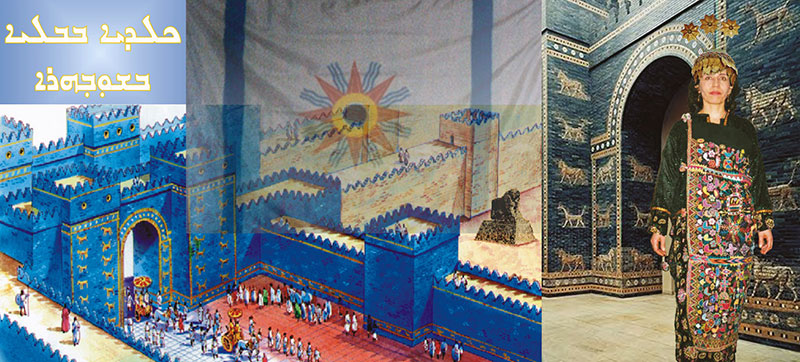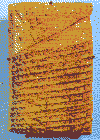
5300BC - Present
By
AMER HANNA-FATUHI
 Mesopotamian literature refers to ancient Chaldeans from the Babylonian Period as Kaldaie (kaldaya, singular). Their homeland is Kaldu, their mother language is Kaldieytha, and their descent and language are Kaldieyoutha, after the Biblical term (Chaldeans). Ancient annuals and syllabic cuneiform records refer to the Chaldeans in the plural form Kaldi (singular, Kaldu) and their homeland (Mat Kaldi / Land of Chaldeans).
Mesopotamian literature refers to ancient Chaldeans from the Babylonian Period as Kaldaie (kaldaya, singular). Their homeland is Kaldu, their mother language is Kaldieytha, and their descent and language are Kaldieyoutha, after the Biblical term (Chaldeans). Ancient annuals and syllabic cuneiform records refer to the Chaldeans in the plural form Kaldi (singular, Kaldu) and their homeland (Mat Kaldi / Land of Chaldeans).
In the Old Testament, they are Kashdim / kasdim (the powerful, mighty or victorious) which according to modern studies and discoveries was derived from the post-dilluvian dynasty of Kish / (Cush, Biblical). This designation was used to refer to their mighty king (Nimrod) who went from Babylon-Kish / Shinar plain to north Mesopotamia, where he built Nineveh and a few other cities. (Gen. 10: 9-12)
The Old Testament also gives the Greek version of the name (Chaldeans), Kaldaniyoun / (kildan, Arabic) which is the common word used nowadays. It appears several times in the Bible / Arabic version.
In Neo Chaldean language around the second millennium BC (Kaldi) and (Kaldu) refer to their homeland i.e. sea-land (Tam-ti Sha Mat-Kaldi).
 Chaldeans lived in a small number in northern Mesopotamia among the Sumerian majority since the unknown age, after the Sumerians’ great resettlement in the south around 3500BC.
Chaldeans lived in a small number in northern Mesopotamia among the Sumerian majority since the unknown age, after the Sumerians’ great resettlement in the south around 3500BC.
The Akkadians, another Proto-Kaldi group, defeated the Shubartu invaders from Bitlis mountains /Turkey, crowds of the Chaldeans started populating the north. In ancient times, the Chaldean homeland covered a vast area from Hamrin mountains in the center of Mesopotamia north of Baghdad and Dayala to the far south (T)Dilmon/ Bahrain and Qatra/ Qatar in the Chaldean Sea / The Gulf.
As evidenced by historical documents and antiquities, Chaldeans, Native Iraqis, are descendants of the Proto-Kaldi who have built three of the earliest cities in southern Mesopotamia around 5300 BC: Eridu, Ur and Uruk (Kulabba), as well as the earliest cities in mid Mesopotamia: Babel, Kish, Sippar and Borsippa during the Pre and post-Diluvian Dynasties.
Similarly, as indicated by tangible / historical discoveries and Biblical data, the two major States in ancient Mesopotamia were Babylonia / Sumer & Akkad in the south and center of Mesopotamia, and Assyria in the north. Local inhabitants of both States were descendants of the Proto-Kaldi (Proto-Euphratians) / Semites. Sumerians, another native Mesopotamian group, shared the land peacefully with the proto-Kaldi. Over time, Sumerians intermingled with the majority of the Chaldean race.
 Although, Chaldeans come under three different designations, they represent one ethnicity. The national / ethnic name of Chaldeans / Chaldaie became commonly known after the Proto-Kaldi designation was used by scholars. “Eastern Syriacs” became the name of Chaldeans upon embracing Christianity in the first Century AD. Syriac is derived from the word Suraya / Suryaya that literally means Christian. However, the word Syriac is used because Christianity was brought into Mesopotamia by the disciple St. Thomas through Syria. As for “Aturaie” it was derived from the word Aturra which denotes Mountain. The name Aturaie was used by a small percentage of our people who have converted to Nestorianism in the 5th century AD and later on they fled to the mountains of Turkey following the Muslim invasion in the 7th century AD. Those people of the mountain went through dramatic blending with the Indo-Europeans of Turkey and Iran. For political reasons, the Aturaie abandoned their ancestors’ ethnic name (Chaldean) and adopted the new, made-up name (Assyrians) based on an agreement between their tribal representative Surma Khanem and Rev. William Ainger Wigram (a British intelligence mercenary). Some of the tribal leaders of the Nestorian tribes of Qochanis who were relocated to Iran, then to Iraq in 1918, under the new made-up name (Assyrians) refused to use anything other than the term Tearaie. However, the new, made-up name (Assyrians) became official when it was approved by the Assyrian Church Synod in1975.
Although, Chaldeans come under three different designations, they represent one ethnicity. The national / ethnic name of Chaldeans / Chaldaie became commonly known after the Proto-Kaldi designation was used by scholars. “Eastern Syriacs” became the name of Chaldeans upon embracing Christianity in the first Century AD. Syriac is derived from the word Suraya / Suryaya that literally means Christian. However, the word Syriac is used because Christianity was brought into Mesopotamia by the disciple St. Thomas through Syria. As for “Aturaie” it was derived from the word Aturra which denotes Mountain. The name Aturaie was used by a small percentage of our people who have converted to Nestorianism in the 5th century AD and later on they fled to the mountains of Turkey following the Muslim invasion in the 7th century AD. Those people of the mountain went through dramatic blending with the Indo-Europeans of Turkey and Iran. For political reasons, the Aturaie abandoned their ancestors’ ethnic name (Chaldean) and adopted the new, made-up name (Assyrians) based on an agreement between their tribal representative Surma Khanem and Rev. William Ainger Wigram (a British intelligence mercenary). Some of the tribal leaders of the Nestorian tribes of Qochanis who were relocated to Iran, then to Iraq in 1918, under the new made-up name (Assyrians) refused to use anything other than the term Tearaie. However, the new, made-up name (Assyrians) became official when it was approved by the Assyrian Church Synod in1975.
 Chaldeans are descendants of Father Abraham who migrated from Ur of the Kaldees to the promised- land (Gen. 12:1 & Gen. 15:7). Not to mention, the most renowned line of kings and queens: A-lu-lim, Ku-Shuma-Bil, Ga-Ur/Gura, and after the great flood Et-anna, Agga, Meshalim, Sargon (first emperor in recorded history), Shamshi Adad I, Hammurabi, Mardukh-Apla-Iddin II / Merodach-Baladan, Napoalpauser, and Nebuchadnezzar II. Ku(g)-bau/Kubaba, the first known Queen in recorded history, as well as Shummuramat / Semiramis the Chaldean born Queen of Assyria who successfully Babylonized Assyria and endorsed Monotheism of worship by recognizing god Nabu (god of writing and knowledge) and son of god of Babylon (Mardukh) as the only true god.
Chaldeans are descendants of Father Abraham who migrated from Ur of the Kaldees to the promised- land (Gen. 12:1 & Gen. 15:7). Not to mention, the most renowned line of kings and queens: A-lu-lim, Ku-Shuma-Bil, Ga-Ur/Gura, and after the great flood Et-anna, Agga, Meshalim, Sargon (first emperor in recorded history), Shamshi Adad I, Hammurabi, Mardukh-Apla-Iddin II / Merodach-Baladan, Napoalpauser, and Nebuchadnezzar II. Ku(g)-bau/Kubaba, the first known Queen in recorded history, as well as Shummuramat / Semiramis the Chaldean born Queen of Assyria who successfully Babylonized Assyria and endorsed Monotheism of worship by recognizing god Nabu (god of writing and knowledge) and son of god of Babylon (Mardukh) as the only true god.
To have a better understanding of the rich history of the Die-hard nation of Chaldeans, and help them stand up for their current challenges. Read the intriguing book entitled “The Untold Story of Native Iraqis”, you can learn about this book by visiting: www.NativeIraqis-Story.com






